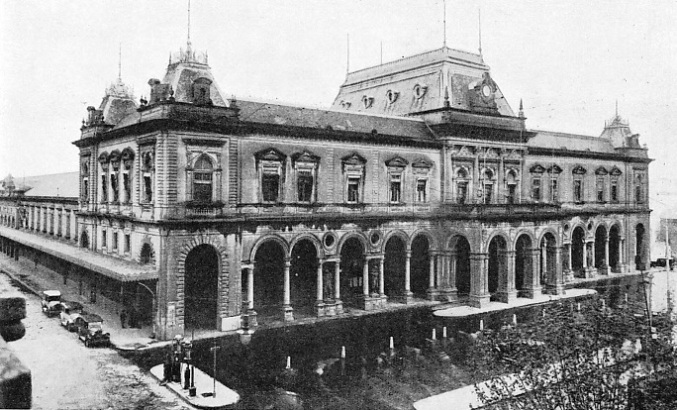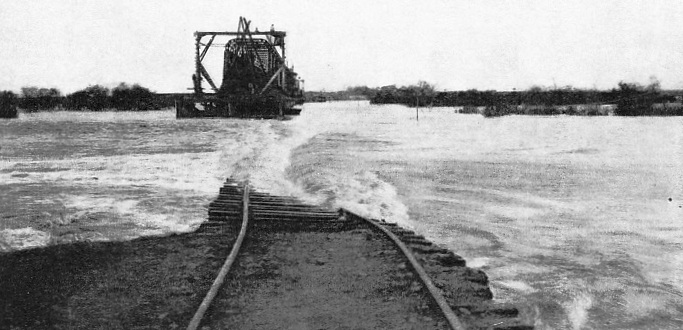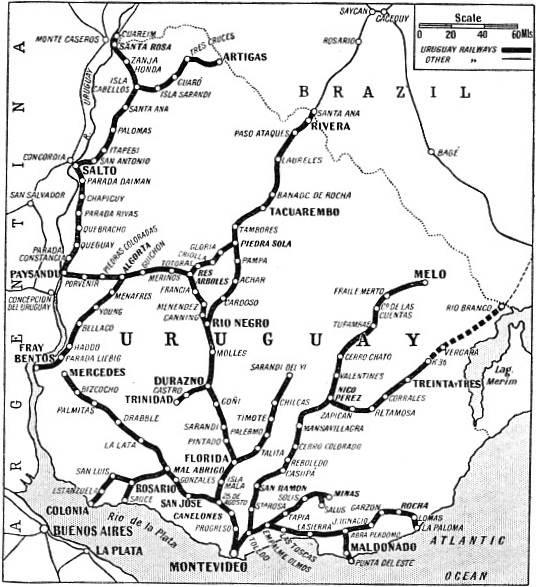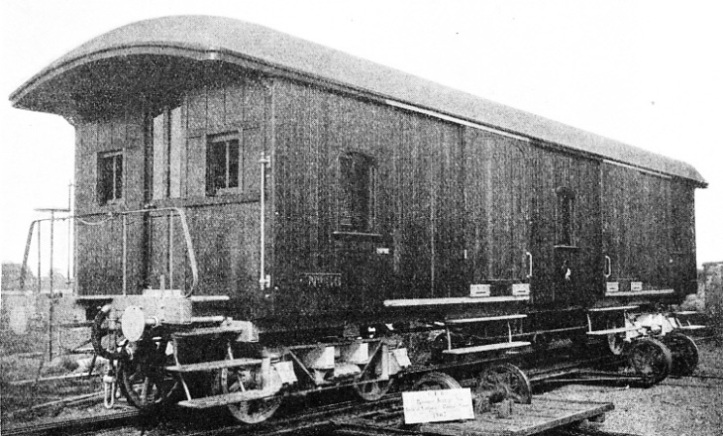
© Railway Wonders of the World 2012-


The Trains of Uruguay
Extensive Developments in a South American Republic

THE CENTRAL STATION AT MONTEVIDEO, owned by the Central Uruguay Railway, is one of the finest stations in South America. It was built in 1878, cost £140,265, and covers an area of some 15,250 sq yds. Montevideo is the most important railway centre in Uruguay.
RAILWAY development in the South American Republic of Uruguay owes much to British enterprise. Nearly all the lines in the country are on the standard gauge of 4 ft 8½ in. The total of standard gauge lines is 1,746 miles, and of this total only 260 miles are owned by the Uruguayan State Railways, the remainder being the property of British companies. There is also a narrow-
Uruguay, after Paraguay, is the smallest of the South American republics, the area being 72,153 square miles, compared with the 50,874 square miles of England, while the population on December 31, 1933, was 1,992,037, or about a quarter of that of London. The names of Fray Bentos and Paysandu are probably far more familiar to British people than the name of Uruguay, as the names of these two towns are carried all over the world on tins of corned beef and other forms of canned meat. It is possible that some people think that the towns are in Argentina, but they are on the Uruguayan side of the Uruguay River, from which the country takes its name.
Uruguay is famous for its cattle and its grain; in 1932 cattle numbered 7,372,000 and sheep 15,405,000. Almost the entire country is given up to grazing. The four cold storage depots of the country dealt with over 1,107,000 sheep and 816,161 cattle in 1933, and cattle wagons of the latest type are, therefore, a feature of the railways.
On the north and north-
A range of hills, the Cuchilla Grande, comes down from Brazil to Montevideo, the isolated mount, the Cerro, giving Montevideo its name. The capital is a handsome city, with a population of about 667,200, and is an important port on the estuary of the River Plate. It lies east of Buenos Aires, the capital of Argentina. The two capitals are connected by a steamship service across the River Plate, the distance being some 120 sea-

SEVERE FLOODS have presented the railway engineer in Uruguay with some difficult problems. This photograph shows a “wash-
Montevideo is the centre of a system of connected railways which cover the country in the manner of the veins of a leaf. There are no odd lengths of lines as there are in Brazil. With excellent railways, some of the best roads in South America, and steamer services that ply over sea and river, the transport of the country is highly competitive and well developed. Sea-
The River Negro and its tributary, the Yi River, flow across the country from north-
The early Spanish settlers were Basques and immigrants from the Canary Islands, while those who settled in what is now the Argentine were from other parts of Spain. Those who are interested both in literature and in Uruguay cannot do better than to read W. H. Hudson’s “The Purple Land that England Lost”, which reveals the romance of this country and will help the reader to understand that a Uruguayan is neither a Brazilian nor an Argentine. La Banda Oriental was the old name of the land and the people called themselves Orientales. For long years the land was a bone of contention, first between the Portuguese and the Spanish, and then between the Brazilians and the Argentines. After a three-

1,746 MILES OF STANDARD-
The railway history of the country dates from 1868, when the construction was begun of the first railway, now a part of the most extensive system of railways in Uruguay. This is the Central Uruguay Railway Company of Montevideo and Associated Lines, which has a total mileage of 980, made up as follows:
Central Uruguay (including North Eastern Line), 273 miles; Central Uruguay Northern Extension, 185 miles; Central Uruguay Eastern Extension, 311 miles; and Central Uruguay Western Extension, 211 miles. This company has also a controlling interest in the Midland Uruguay Railway and Associated Lines. The Midland Uruguay lines total 506 miles, and are composed of Midland Uruguay Railway, 285 miles; Extension Railway, thirty-

PASSENGER BAGGAGE VAN built in 1907 at the shops of the Central Uruguay Railway. These shops are situated at Penarol, seven miles from the Central Station at Montevideo.
The State Railways of Uruguay have 260 miles of track, and the headquarters are at Montevideo.
The Central lines form the main traffic artery running north from Montevideo to Rivera, near the border of Brazil. This links with the principal towns and ports of Uruguay as well as connecting with the Brazilian railways, so that there is a direct rail route to Sao Paulo, Santos, and Rio de Janeiro. In addition to this connexion with the Brazilian railways there is another which is on the Midland lines, referred to later in this chapter. The Central Uruguay Railway is the parent railway system. The company was formed in London in December, 1876, to acquire the railway of the same name which had been established in Uruguay to work a concession granted by the Government in 1866, A line 127 miles long was to be built from Montevideo to Durazno, on the Yi River. Thence, after bridging the river, it was to proceed northward. This line was built to Durazno, and the next section of thirty-

FIRST-
In 1886 the company bought a line which had been built from Station 25 de Agosto, thirty-
In 1889 the North Eastern was acquired. This line goes north-
The Central, having -
There is only one tunnel on the whole of the Central lines, and this is on the trunk line to Rivera and Brazil. It must not be supposed that Uruguay is a dull country because it has no mountains of heights exceeding 2,000 feet. The landscape is varied. On the way to Rivera the line passes through pretty scenery, especially in the Department of Tacuarembo, where the tunnel occurs, at Banado de Rocha; the tunnel is 250 yards long. Los Tam-

TRACK RENEWALS in the yard of the Central Uruguay Railway Station at Montevideo. The track seen above is spiked in accordance with the general American practice. The lines converging on the city of Montevideo carry a heavy suburban traffic.
In such a well-
The Central Station at Montevideo is a handsome structure. The workshops are at Penarol, seven miles from the terminus. The first engine used on the line was built in 1867 by Manning and Wardle, and was a saddle-
There are now 129 locomotives, most of which were built in Great Britain. Twenty-
Paysandu is the headquarters of the Midland system, which links with the Central at Rio Negro and Piedra Sola. Paysandu, with a population of about 31,000, is the biggest town in the Republic after Montevideo. The relationship between the railways and the Uruguay River is interesting. In addition to Paysandu there are two other towns of importance on the Uruguayan side of the river, these being Salto, the third city in the country, having a population of 30,000, to the north of Paysandu, and Fray Bentos to the south. The river is navigable up to Salto, above which vessels from Montevideo cannot proceed because of the rapids. The railway, however, proceeds roughly parallel with the river but some distance from it northwards to Santa Rosa on the Brazilian border, and establishes contact with the Brazilian railways, Cuareim being the town on the other side of the border. The metre-
The trunk line from Montevideo to Santos and Rio de Janeiro intersects this line at a point rather more than a third of the way across country, while at a point much nearer the Atlantic coast the Uruguayan State Railway is being extended from Treinta y Tres towards the border, whence a line is projected to join the Brazilian railway at the town of Bazilio. The gauges of the Uruguayan lines and those of the North-
At the time of writing the engineers considering the proposed bridge across the River Uruguay are consulting as to whether the track on the bridge should be metre or standard gauge. It is proposed to build a bridge about a mile and a quarter long, with provision for a railway track, motor vehicles, and foot passengers. The cost is expected to be about £1,000,000. The bridge will have a marked effect on the transport of the area, as Rio Grande, the port at the other end of the line across Brazil, is one of the chief ports of that country.
Connexions with Brazil
The line of the Midland Uruguay Railway goes east from Paysandu to Algorta (forty-
Northward from Paysandu the line runs to Salto, sixty-
The Midland system has forty-
It was not until 1915 that the State Railways came into being when the Government began by acquiring some twelve miles of track and building new lines. Some of the lines are branches or extensions linking with the companies’ lines. An example is that from Durazno, on the Central line, 127 miles from the capital, to Trinidad, a section which is thirty miles long. Both towns are cattle, grain and agricultural centres and each has about 10,000 inhabitants. This line was built by the Govern-

SEVERAL LARGE BRIDGES have been built on the Central Uruguay system. One of the longest is the Yi Bridge, here seen under construction; it has a length of over 680 yards. This picture shows the erection of the eleventh span. The bridge has forty-
You can read more on “British Enterprise in South America”, “Main Lines of Brazil” and “The Magic of the Andes” on this website.